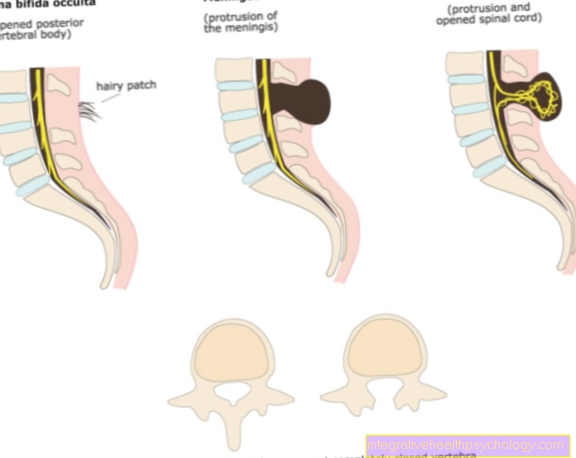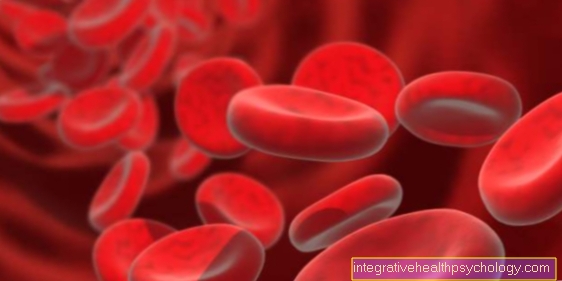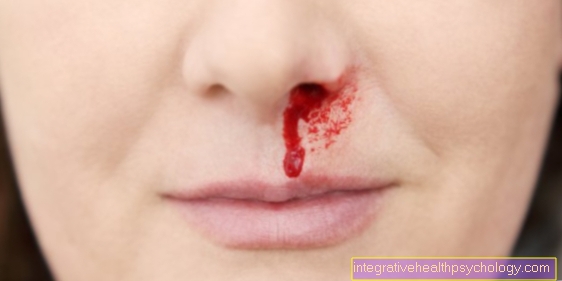Amlodipine
General
Amlodipine is a blood pressure lowering drug.
In addition to being used as a basic drug for high blood pressure (arterial hypertension) it is also used for chronic tightness in the chest (angina pectoris) and for the prevention of acute angina pectoris attacks in Prinzmetal's angina.
From a pharmacological point of view, it belongs to the class of calcium channel blockers. Amlodipine has a long half-life and therefore remains in the body for a long time, which is why it has to be taken less often.
On the market there are Amplodipine and others. under the trade name Norvasc®.

effect
Amlodipine has a dilating effect on the smooth vascular muscles. This enables the active ingredient to counteract high blood pressure.
It belongs to the group of calcium channel blockers. Since the calcium concentration in the cells determines the state of vascular contraction, amlodipine can act here.
Normally, stimulation of the so-called slow voltage-dependent L-type calcium channels leads to increased tension in the smooth muscles of the heart and blood vessels. This leads to an increase in blood pressure.
Amlodipine inhibits the influx of calcium into the cells. It causes blood vessels to dilate. As a result, the active ingredient ensures a lowering of the so-called peripheral resistance and thus a lowering of blood pressure. It does not work on the conduction system of the heart.
Due to its effect, however, it triggers a reflex activation of the so-called sympathetic nervous system (part of the vegetative nervous system). This manifests itself in the form of an increase in the heart rate and an increased consumption of oxygen. To counteract this, amlodipine preparations are usually given in conjunction with so-called ß-blockers.
Compared to other calcium channel blockers, amlodipine has a lower level of sympathetic activation. It has been shown to reduce so-called mortality and, to a certain extent, reduce the risk of stroke. Therefore, it is used as the standard active ingredient against high blood pressure. One disadvantage is that it does not work adequately in so-called unstable angina pectoris and recent heart attacks.
Dosage and intake
The intake and dosage of the active ingredient amlodipine should always be agreed with the attending physician.
The usual dose for adults is 5 mg once a day to start with. The dose can later be increased to 10 mg once a day.
For children and adolescents aged 6 to 17 years and for the elderly, a starting dose of 2.5 mg daily is usually recommended. The maximum recommended dose for this age group is 5 mg daily.
Regular intake is important for the success of the treatment.
In the event of complaints or uncertainties, the attending physician should be consulted.
Amlodipine is usually only taken once a day due to its long half-life.
For the treatment of high blood pressure, the average dose is 5 mg and the maximum dose is 10 mg.
In the treatment of chest tightness (angina pectoris), 5-10 mg is usually used, but most patients need 10 mg for an adequate effect. In older patients, it is advisable to start with a lower dose of 2.5 mg for both symptoms, since heart, liver or kidney damage is more common in old age, which promotes longer retention of the drug in the organism and thus increases the effect to lead.
Before taking it, it is important to inform the attending physician about any amlodipine allergies or allergies to other medications. In addition, the attending physician must be aware of all other medications taken in order to avoid interactions and allergic reactions.
When taking amlodipine, there is no need to worry about meals. However, in order to ensure a constant effective level, it should be taken at a similar time each day.
While you are taking amlodipine, it is important to tell other doctors, such as the dentist, that you are currently taking the drug.
Furthermore, the attending physician must be informed about an existing pregnancy, current breastfeeding of an infant or an existing desire to have children in order to adequately advise the patient on the advantages and disadvantages of taking amlodipine under these circumstances.
What should be considered when stopping the drug?
Amlodipine is a blood pressure lowering drug. All medicines in this group should not be suddenly stopped.
Taking the drug reduces the number of so-called receptors in the body that otherwise keep blood pressure low. The body needs some time to adjust again and to efficiently take over the lowering of blood pressure.
If the drug is suddenly discontinued, the blood pressure can rise suddenly and in an uncontrolled manner. This, in turn, can lead to a stroke.
Any change in the dosage of amlodipine must therefore be discussed with the attending physician.
In very few cases, an antihypertensive agent can be completely discontinued. This is possible if the body was previously massively overweight, which has raised the blood pressure. The prerequisite is that the body weight has been reduced enormously and the blood pressure permanently reaches a value that can be maintained without medication. However, this happens less often.
Side effects
Due to the antihypertensive effect of amlodipine, the following occurs very frequently (> 10%) in patients:
- Water retention in the extremities, most commonly in the legs (Edema). This phenomenon is usually observed two to three weeks after starting therapy.
- In addition to this, water can also be retained in the lungs, known as pulmonary edema.
- Furthermore, the blood pressure lowering effect can be too fast and too strong for the patient, so that the blood pressure becomes too low (Hypotension). As a result, the patient may faint more often. Therefore, it is important to lower blood pressure at a rate and at a time that is well suited to the patient's clinical conditions.
At the beginning of therapy there can sometimes also be an initial increase in symptoms and a reflex increase in heart rate (Reflex tachycardia) come.
These side effects usually go away by themselves with long-term use of amlodipine and occur especially in patients with narrowed heart arteries (coronary heart disease, CHD) who are not taking any other antihypertensive drugs at the same time.
The following side effects are common (1 - 10%):
- Cardiovascular: The conscious awareness of your own heartbeat (Palpitation)
- Central nervous system: fatigue, dizziness
- Skin: rash, itching
- Sexually: erectile dysfunction in men
- Gastrointestinal: vomiting, abdominal pain
- Muscles: muscle cramps and muscle weakness
- Breathing: shortness of breath.
Many other symptoms can occur rarely (<1%) or very rarely (<0.1%), of which only particularly important or life-threatening side effects are listed below:
- allergic reactions up to anaphylactic shock
- Cardiac arrhythmias (arrhythmia)
- depression
- Inflammation of the liver (hepatitis)
- increased blood sugar (Hyperglycemia)
- Insomnia (Insomnia)
- Jaundice (Jaundice)
- Discomfort when urinating (Micturition disorders)
- Muscle aches (Myalgias)
- Inflammation of the pancreas (Pancreatitis)
- Stevens Johnson Syndrome
- Fainting (Syncope)
- Palpitations (Tachycardia)
- Inflammation of the vessels (Vasculitites)
Contraindications
Amlodipine should only be used with special care Patients with narrowing of the aortic valve (see p. Aortic stenosis) given, as the blood pressure lowering effect of the drug leads to reduced blood flow to the Heart can come what turn a Heart attack could trigger.
In patients with previously damaged liver A lower starting dose (2.5 mg or less) should be selected when starting therapy with amlodipine, since amlodipine is processed in the liver and, if the liver is damaged, it remains in a higher dose and thus remains functional in the blood for longer, so that the blood pressure may be lowered too much even though you have taken the correct dose.
In animal experiments it could be shown that amlodipine harmful to the unborn baby works. Since there are understandably no comparable studies in humans, is general the use of amlodipine is not recommended during pregnancy. There are no studies on side effects during breastfeeding as to why not recommended for use during breastfeeding becomes.
Please also read: Medication during pregnancy
Combination and interaction with other substances
Amlodipine is often used in basic therapy Beta blockers combined, as both drug groups together can lower blood pressure better.
When it comes to nutrition, you have to be special on the consumption of grapefruit or grapefruit juice be careful, as this can easily increase the amlodipine concentration in the blood.
In addition, you should Foods, especially herbs, that either lower or increase blood pressure, because consuming them can derail the correctly set blood pressure. If you are particularly susceptible to these foods, we recommend that you get nutritional advice from a trained nutritionist.
Amlodipine can interact with many common drugs, very often the amount in the blood and thus the effect of one of the two drugs is changed.
Commonly used drugs that amlodipine interacts with include:
- Barbiturates
- Beta blockers
- Clopidogrel
- Cyclosporine
- Macrolides
- MAO inhibitors
- Melatonin
- Phenytoin
- Simvastatin.
It is therefore particularly important to inform the attending physician precisely about the current list of medications before prescribing amlodipine.
Amlodipine and alcohol - are they compatible?
Amlodipine causes the blood vessels to widen and thus lower blood pressure. Alcohol can have the same effect. If both are consumed at the same time, the blood pressure can be greatly reduced. This can increase the side effects of amlodipine. It can trigger dizziness, circulatory instabilities and even life-threatening cardiovascular problems. It is advised to avoid alcohol whenever possible when taking amlodipine.
Impotence side effect
Whether antihypertensive agents such as amlodipine lead to impotence is controversial. Different studies show different results.
On the one hand, a connection between erectile dysfunction and diseased, constricted blood vessels, for example in people with diabetes mellitus, overweight or smokers, is suspected.
Vasodilation with antihypertensive agents such as amlodipine did not show a direct relationship between taking the drug and impotence in some studies.
On the other hand, slightly more erectile dysfunction could be detected when taking beta blockers.
Since amlodipine is often given in combination with beta blockers, the side effect of impotence cannot be completely ruled out.
In addition, the reason could possibly lie in the biochemical structure of amlodipine. Because it is a modification of the so-called nifedipine. Because nifedipine causes an increase in cholesterol in the sperm. The cholesterol lies on the sperm membrane and prevents the receptors from protruding out of this membrane. This means that they cannot dock onto the egg cell. It comes to the inability to conceive. When nifedipine was stopped, fertility returned after three months. It is not certain whether this mechanism is similar to amlodipine.
Can amlodipine tablets be halved?
The divisibility of the amlodipine tablets depends on the preparation. It is noted in the package insert when the tablets can be halved. For example, the tablets of the preparation Amlodipine - 1 A Pharma® 5mg Tablets N can be halved. Amlodipine tablets are available in different dosages, now there are also 2.5 mg tablets.
If you are unsure about the division, it is advisable to ask your doctor or pharmacist.





























